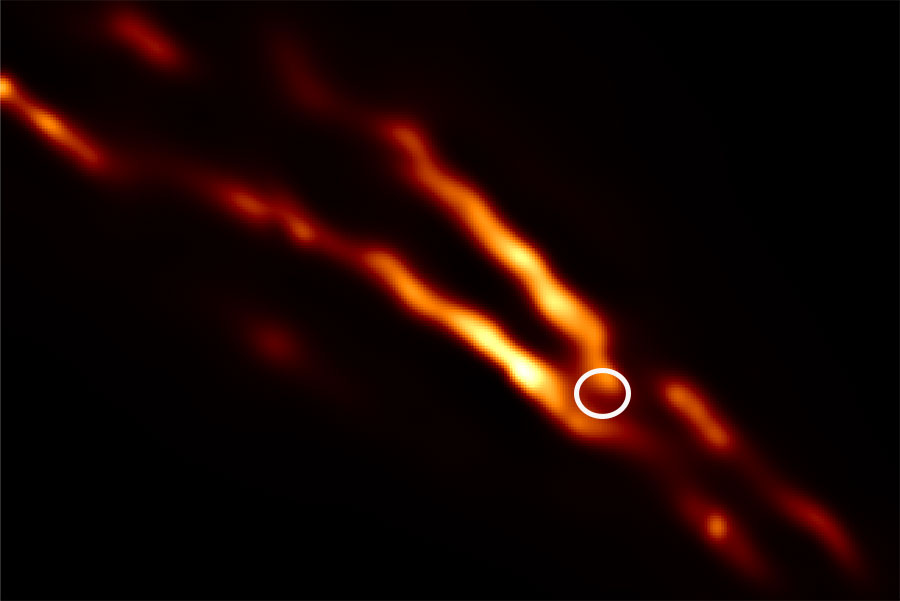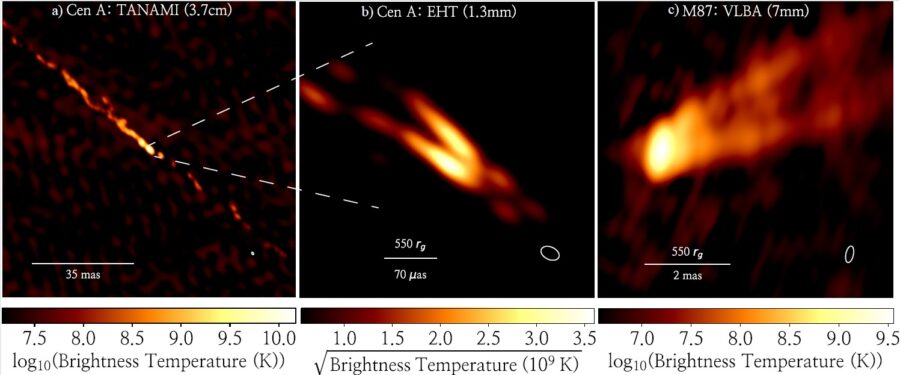Observations of the nearest radio galaxy, Centaurus A, provide the highest-resolution look at the long jets shooting from the galaxy’s supermassive black hole.
Scientists with the Event Horizon Telescope collaboration have peered deeply into the heart of the radio galaxy Centaurus A, revealing details of its long, powerful jets. The results appear July 19th in Nature Astronomy.
Cen A lies about 12 million light-years from us and hosts a supermassive black hole that’s actively swallowing gas and shooting out a narrow jet from top and bottom. The black hole isn’t a terribly voracious eater, compared with the leviathans that power quasars. But the galaxy is so close — and the jets tilted at just the right angle — that we can easily see the jets at radio wavelengths.
The team used observations taken at seven sites scattered across Earth’s western hemisphere, obtained during the EHT’s April 2017 campaign. Much as they did when reconstructing the now-iconic M87 black hole image, the team divided to conquer: A dozen individuals on the team worked independently to make 12 different images from the EHT data, using a range of methods. Then the team compared the results, weeded out the worst, and worked together to produce a final, reliable image.

M. Janssen et al. / Event Horizon Telescope
The image looks peculiar at first glance. Hidden from view is the black hole; the team thinks it’s somewhere in the white circle. Given that marker, you’d be forgiven for thinking the black hole is shooting out four jets, but that’s not what’s happening. Instead, we’re looking at the edges of two jets, one pointing toward us (left) and the other counterjet pointing away (right).
Based on years of detailed simulations, astronomers think that the center of a black hole’s jet (its “spine”) is largely empty — it’s essentially a giant, corkscrew-like magnetic field with a few electrons and other particles zooming through, explains team member Michael Janssen (Max Planck Institute for Radio Astronomy, Germany). But sheathing this spine are an immense number of particles, which either blow off the black hole’s big fluffy gas disk or come from the surrounding galaxy. Because the jet doesn’t point directly at us, the glow from the fast-moving spine largely misses our line of sight, like a flashlight angled away from our eyes. But the ionized gas along the jet’s edges is moving around in a slower, less streamlined way, and its electrons are spiraling around the jet’s corkscrew. Those electrons emit photons at all sorts of angles, and the geometry works out such that we can see the edges quite well.
“What should be emphasized is how incredibly rare it is to have images on this scale, so close to the black hole,” says astronomer Eileen Meyer (University of Maryland, Baltimore County), who wasn’t involved with the study. “There are basically four or five. So any new data on this scale is important.”
Especially interesting, both the team and Meyer point out, is that the edge-brightened jet structure also appears in the active galaxies M87, Markarian 501, and 3C84. These galaxies’ black holes all scarf down gas at fairly low rates, like Cen A’s. This trend may indicate there’s something universal going on in such systems.

Nature Astronomy
Alas, the EHT can’t unmask Cen A’s black hole shadow: at 55 million solar masses, the black hole is too small to be resolved at these distances. Astronomers will need to move to higher radio frequencies — 100 times higher than what the EHT observes — and that means going to space. Linking two or more satellites together to work as an interferometer would potentially give astronomers the resolution they need, Janssen says.
Reference: M. Janssen et al. “Event Horizon Telescope observations of the jet launching and collimation in Centaurus A.” Nature Astronomy. Published online July 19, 2021.
 10
10









Comments
Anthony Barreiro
July 19, 2021 at 1:11 pm
I'm not so good at math. How big are these jets?
In the second set of figures, for Centaurus A 550 rg = 70 microarcseconds, while for M87 550 rg = 2 milliarcseconds. What's an rg?
Also in the second set of figures, each image has a little white ellipse. What does that represent?
Thanks!
You must be logged in to post a comment.
louis-robinson
July 19, 2021 at 11:17 pm
My apologies: I'm blanking on the exact definition of Rg at the moment, but it's a "radius" associated with the event horizon, and thus the mass, of the black hole. What it indicates is the scale of the images wrt the engine driving the jets. The images are at a similar scale, and the jets turn out to be very much alike despite the 3 orders of magnitude difference in the masses of the black holes.
The ellipse is the synthesized beam of the telescope in the configuration used to create the image. It shows you how large the smallest fully-resolved elements in the image are.
You must be logged in to post a comment.
Anthony Barreiro
July 20, 2021 at 4:38 pm
Thank you very much. The images convey a lot more information now.
You must be logged in to post a comment.
Anthony Barreiro
July 21, 2021 at 9:07 pm
I still haven't done the math, but if these images are on scales of milliarcseconds and microarcseconds, only a few hundred times the size of the black holes, they're pictures of the jets very close to the black holes, way deep in the centers of the galaxies, right? These aren't the entire jets that we see shooting out of the galaxies in other images, right?
You must be logged in to post a comment.
Yaron Sheffer
July 22, 2021 at 5:23 pm
A 55 mil. BH has a radius of 1 AU. So 550 AU for the scale of Cen A, and about 60,000 AU (1 ly) for the scale of the 100 times bigger BH of M87. Way deep in the centers, indeed. These jets can end up being millions of light years in extent.
You must be logged in to post a comment.
Anthony Barreiro
July 22, 2021 at 9:16 pm
Thanks Yaron. This scale helps me understand the images.
You must be logged in to post a comment.
Anthony Barreiro
July 24, 2021 at 6:31 pm
I'm finally drawing on my experience looking through various telescopes at star parties and observatories. In general, the bigger the aperture, the narrower the field of view. EHT is the biggest telescope ever created!
You must be logged in to post a comment.
Peter Wilson
July 19, 2021 at 2:43 pm
And does "log_10(Brightness Temperature (K))" mean that the white parts of the figure are 10,000,000,000K?
And does "sqrt(Brightness Temperature x (10^9 K))" also mean that the white parts of the figure are 10,000,000,000K?
You must be logged in to post a comment.
Andrew James
July 19, 2021 at 8:02 pm
The paper says: "The intensities of the brightest, central southeast and northwest jet components in the unconvolved image are 32×10^9 K and 20 ×10^9 K, respectively.'' The brightness temperatures (K) shown are related to flux densities in Jansky (Jy)
You must be logged in to post a comment.
Anthony Barreiro
August 4, 2021 at 1:24 pm
Today's Astronomy Picture of the Day has four pictures of Centaurus A, each more zoomed in than the previous. The Event Horizon Telescope image of the center of the jets is at the same scale as a picture of a golf ball on the Moon as seen from Earth.
https://apod.nasa.gov/apod/ap210804.html
You must be logged in to post a comment.
You must be logged in to post a comment.